Explore the Japanese Covered Bridge (Cau Pagoda) in Hoi An, Da Nang City! Discover ticket prices, opening hours, unique architecture, and sustainable tours for a UNESCO adventure. Book with Legend Travel Group today!
The Japanese Covered Bridge, also known as Cau Pagoda or Chùa Cầu, is an iconic symbol of Hoi An Ancient Town, now Minh An Ward in Da Nang City, following the merger of Quang Nam Province. Built in the early 17th century by Japanese merchants, this UNESCO World Heritage Site spans a small tributary of the Thu Bon River, connecting Tran Phu and Nguyen Thi Minh Khai streets. Renowned for its distinctive architecture blending Japanese, Vietnamese, and Chinese influences, the bridge attracts thousands of Da Nang’s 8 million annual visitors with its romantic charm, sacred pagoda, and cultural significance. As a testament to Hoi An’s trading port legacy, it offers a glimpse into the town’s multicultural past. With sustainable tourism initiatives preserving its heritage, it’s a must-visit for history buffs and eco-conscious travelers. Legend Travel Group, a leader in sustainable tourism, offers eco-friendly tours to explore this historic gem, bookable via links throughout this guide. Step into Hoi An’s past—reserve your tour now
Legend Travel Group delivers authentic Southeast Asia experiences, prioritizing sustainability and cultural immersion. Our Hoi An tours feature low-impact transport like bicycles and electric shuttles, guided by local experts who share the bridge’s history and significance. We support Minh An’s artisans and align with Da Nang City’s “Green Heritage” initiative to preserve UNESCO sites. With transparent pricing, free cancellations up to 48 hours before departure, and 24/7 support, we ensure a seamless visit. Discover the Japanese Covered Bridge responsibly with our curated tours—book via the links on this page!
Quang Nam Province has merged into Da Nang City, integrating Hoi An as Minh An Ward and the Japanese Covered Bridge as part of this UNESCO-protected area. This restructuring eliminates the district level, but Hoi An’s cultural heritage remains robust. Da Nang City enhances sustainable tourism with cycling paths, electric buses, and a VND500 billion flood mitigation project (2023), ensuring access to the bridge, though November floods may affect surrounding streets.
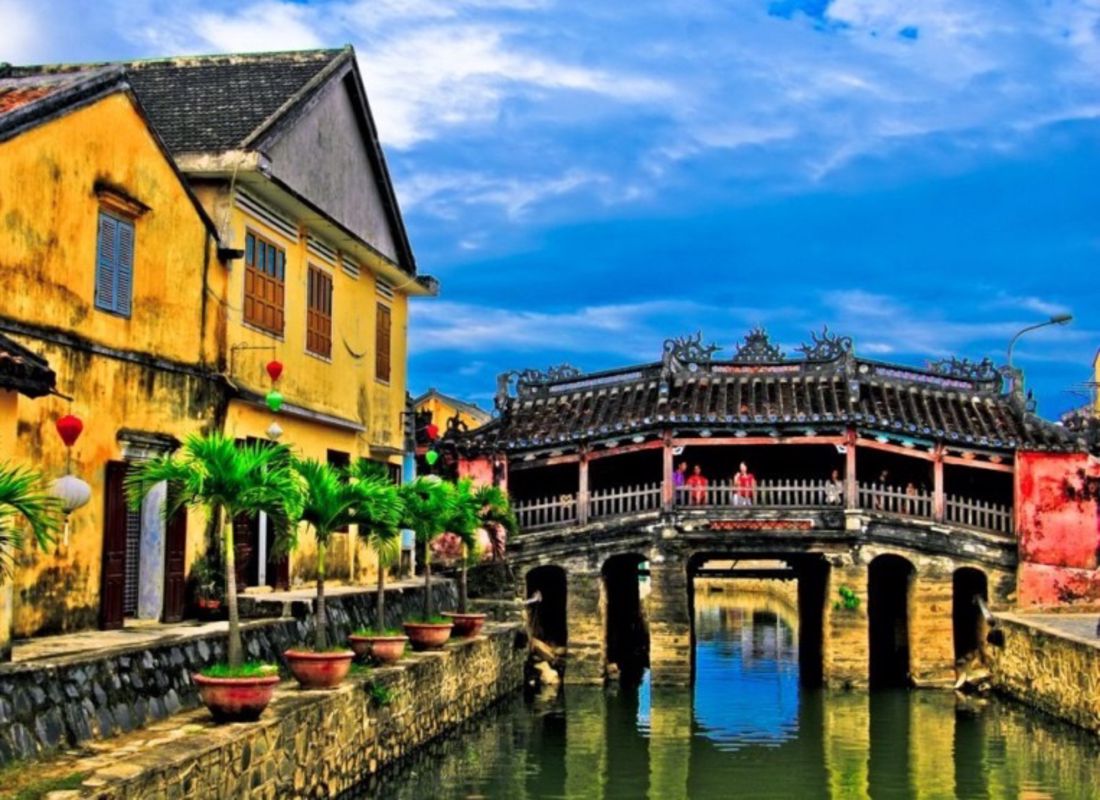 Photograph the historic allure of Hoi An’s heritage (Source: Internet)
Photograph the historic allure of Hoi An’s heritage (Source: Internet)Constructed around the 1590s by Japanese traders, the Japanese Covered Bridge is one of Hoi An’s oldest structures, symbolizing the town’s role as a 17th-century trading hub. Spanning 18 meters over a Thu Bon River tributary, it connects the Japanese and Chinese quarters, fostering cultural exchange. In 1653, a pagoda was added, forming a T-shaped structure dedicated to Tran Vo Bac De, the Northern Deity protecting against storms, not Buddha, as is typical in pagodas. Named “Lai Vien Kieu” (Bridge for Faraway Guests) by Lord Nguyen Phuc Chu in 1719, it reflects Hoi An’s welcoming spirit. Restored in 1817, 1865, 1915, 1986, and most recently in 2024 (reopened August 3, 2024, after a two-year project), the bridge retains its original charm despite some debate over modernized elements like new tiles and paint.
The bridge’s architecture is a fusion of styles: a Japanese curved wooden frame with vermilion accents, a Vietnamese yin-yang tiled roof, and Chinese carvings on trusses. Flanked by dog and monkey sculptures—sacred in Japanese culture, tied to zodiac years of Japanese emperors—it embodies spiritual and aesthetic harmony. A stone stele records its history, and the pagoda’s altar honors Tran Vo Bac De, reflecting local beliefs in flood protection. Depicted on Vietnam’s 20,000 VND note, the bridge is a national cultural relic (1990) and a photographer’s delight, especially at sunset or during the Full Moon Lantern Festival.
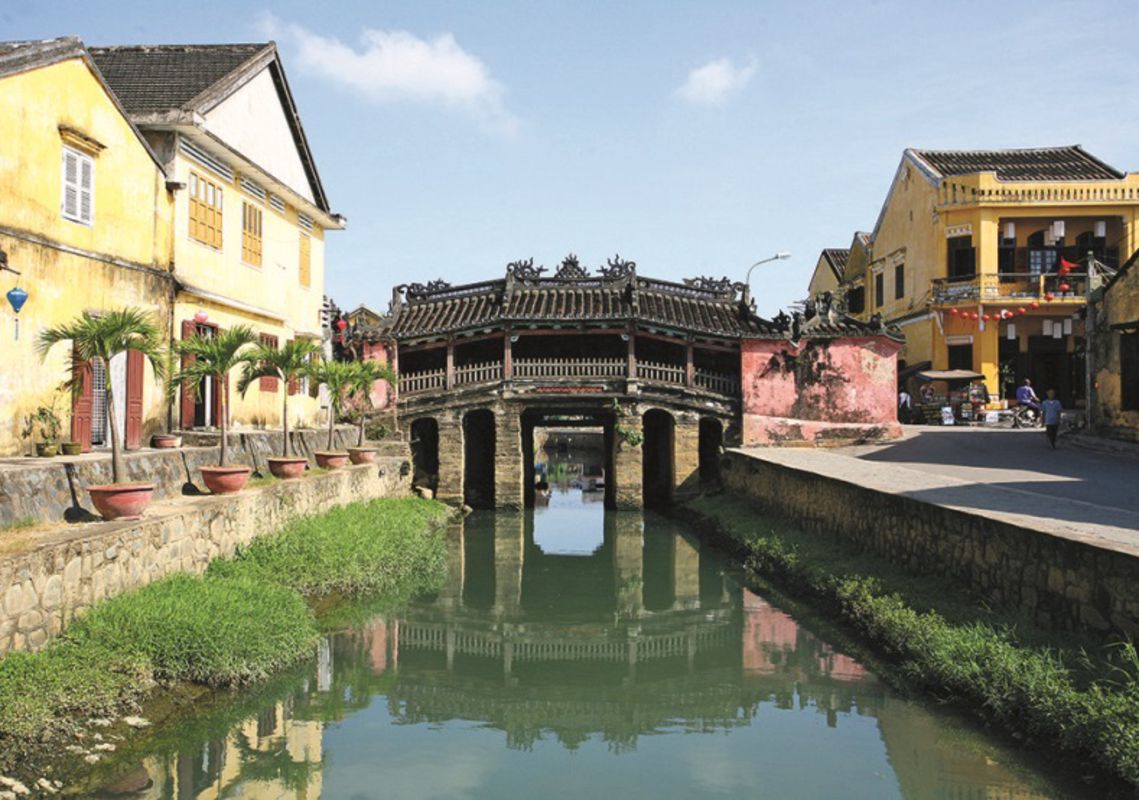 Experience Hoi An Tours with sustainable exploration (Source: Internet)
Experience Hoi An Tours with sustainable exploration (Source: Internet)Visiting the Japanese Covered Bridge requires an Hoi An Old Town entry ticket, which funds UNESCO preservation efforts:
Foreign Tourists (Adults and Children Over 15): $6 (120,000 VND) per person, covering 5 of 22 attractions (e.g., Japanese Covered Bridge, Tan Ky House).
Vietnamese Tourists (Adults and Children Over 15): $3.20 (80,000 VND) per person.
Children (Under 16): Free entry.
Seniors (Over 60) and Veterans: Discounted per Vietnamese law.
Hoi An Residents: Free with ID.
Where to Buy: Ticket booths at Old Town entrances (e.g., Tran Phu, Nguyen Thi Minh Khai) or included in Legend Travel Group tours.
Validity: Ticket valid for your entire stay; retain for re-entry.
Note: Tickets are checked at the bridge’s entrance; carry exact VND as booths may not accept cards. Prices stable but may adjust slightly in peak seasons (March–August).
Hours: Open 24/7 as part of Hoi An Old Town’s pedestrian zone, but ticketed access to the pagoda interior is 8:00 AM–6:00 PM daily, including holidays and Tet.
Best Times:
Early Morning (8:00–10:00 AM): Cooler (24–28°C or 75.2–82.4°F), fewer crowds, ideal for photos.
Evening (5:00–6:00 PM): Sunset glow and lantern-lit ambiance; vibrant during Full Moon Lantern Festival (14th lunar day monthly).
Dry Season (February–August): Clear skies; avoid November flooding risks.
Note: Pagoda interior may close during heavy rain; pedestrian zone restricted 8:30 AM–11:00 AM, 3:00 PM–9:30 PM, requiring ticket checks.
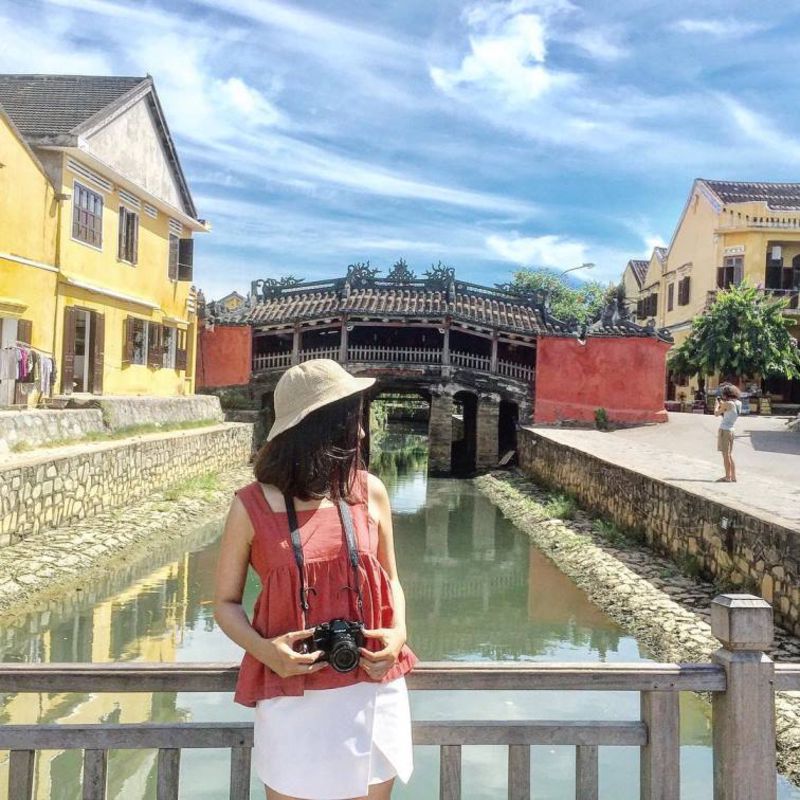 Start your Hoi An Travel with tranquil vibes (Source: Internet)
Start your Hoi An Travel with tranquil vibes (Source: Internet)The Japanese Covered Bridge is centrally located at the intersection of Tran Phu and Nguyen Thi Minh Khai streets in Minh An Ward, 4 km from An Bang Beach and 28 km from Da Nang. Sustainable travel options include:
Walking (Recommended):
Cost: Free.
Duration: 5–10 minutes from Old Town center (e.g., Hoi An Market, 200 m).
Sustainable: Zero-emission; explore lantern-lit streets.
Tip: Follow Tran Phu Street; use Maps.me for navigation.
Bicycle:
Cost: $1–$2/day (25,000–50,000 VND).
Duration: 2–5 minutes.
Sustainable: Eco-friendly; park outside pedestrian zones.
Tip: Rent from Hoi An Bike Rental (+84 961 172 423); included in our Hoi An Heritage Cycling Tour ($55–$75).
Cyclo:
Cost: $2–$5/trip (50,000–125,000 VND).
Duration: 5–10 minutes.
Sustainable: Supports local drivers.
Tip: Book at Tran Phu Street; ideal for short hops.
Bus #1:
Cost: $0.80–$1.20 (20,000–30,000 VND) to Hoi An Bus Station; 10-minute walk to bridge.
Duration: 60–75 minutes.
Sustainable: Low-emission buses; use DanaBus app.
Tip: Departs every 15–20 minutes (5:00 AM–9:00 PM).
Taxi/Grab:
Cost: $12–$15 (300,000–375,000 VND); Xanh SM electric taxis $13–$16 (325,000–400,000 VND).
Duration: 45–60 minutes.
Sustainable: Xanh SM reduces CO2 by 30%.
Tip: Book via Grab or Mai Linh (+84 236 352 5252).
Guided Tours:
Cost: Group tours $10–$45 (250,000–1,125,000 VND); private tours $80–$120 (2,000,000–3,000,000 VND).
Duration: Half-day (4–6 hours) or full-day (8–10 hours).
Sustainable: Legend Travel Group uses electric shuttles.
Tip: Included in our Hoi An Heritage Walking Tour ($55–$75).
Note: Old Town is pedestrianized (8:30 AM–11:00 AM, 3:00 PM–9:30 PM); park bikes/motorbikes at designated lots ($0.25–$0.60 or 6,250–15,000 VND).
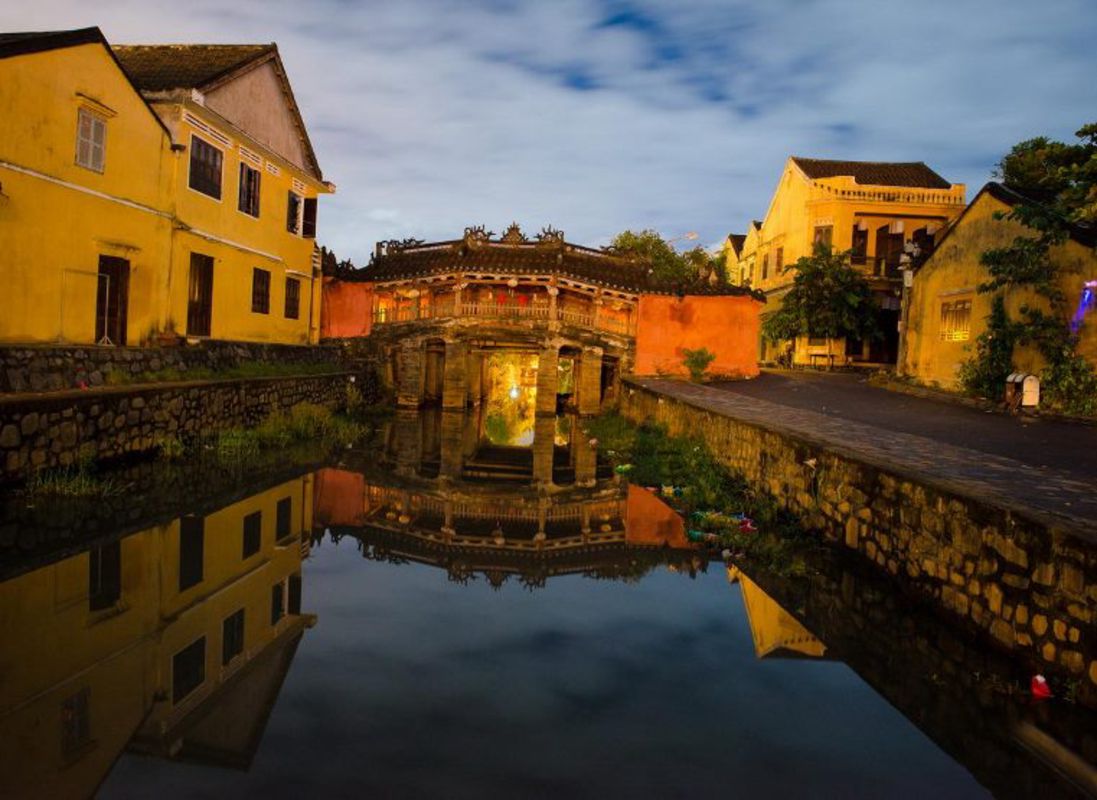 Learn Hoi An’s heritage with expert insights (Source: Internet)
Learn Hoi An’s heritage with expert insights (Source: Internet)Overview: Marvel at the bridge’s 18-meter wooden structure, with its yin-yang tiled roof, vermilion-painted frame, and intricate carvings blending Japanese, Vietnamese, and Chinese styles. The pagoda houses a wooden statue of Tran Vo Bac De, not Buddha, reflecting local flood-protection beliefs.
Cost: Included in Old Town ticket ($6 or 120,000 VND).
Time Needed: 15–30 minutes.
Sustainable Tips: Avoid touching carvings; use digital QR guides (2023) for history.
Highlights: “The bridge’s design is a cultural fusion!” (Tripadvisor, 4.5/5 stars).
Tip: Photograph from Hoai River banks at sunset; included in our Hoi An Heritage Walking Tour ($55–$75).
Overview: Enter the small pagoda to view the Tran Vo Bac De statue and offer prayers for safety and prosperity. The T-shaped layout and Chinese inscriptions on trusses highlight its multicultural roots.
Cost: Included in Old Town ticket ($6 or 120,000 VND).
Time Needed: 10–15 minutes.
Sustainable Tips: Maintain silence; support local artisans by buying nearby crafts.
Highlights: “The pagoda’s serenity is captivating” (Tripadvisor, 4.6/5 stars).
Tip: Dress modestly (covered shoulders, knees); visit early to avoid crowds.
Overview: Experience the bridge glowing with lanterns during the monthly Full Moon Lantern Festival (14th lunar day), with river boats and street performances enhancing the romantic ambiance.
Cost: Included in Old Town ticket ($6 or 120,000 VND); boat rides $6–$8/boat (150,000–200,000 VND, up to 4 people).
Time Needed: 1–2 hours (6:00 PM–10:00 PM).
Sustainable Tips: Use eco-friendly boats; avoid plastic waste.
Highlights: “The lantern-lit bridge is magical!” (Tripadvisor, 4.8/5 stars).
Tip: Book boats via Klook; check lunar calendar. Included in our Hoi An Night Glow Tour ($55–$75).
Overview: Walk along the Hoai River’s banks or explore Tran Phu and Nguyen Thi Minh Khai streets, lined with cafes, tailor shops, and historic houses like Tan Ky House (included in Old Town ticket).
Cost: Free; dining $1–$5 (25,000–125,000 VND); tailoring $20–$100 (500,000–2,500,000 VND).
Time Needed: 1–2 hours.
Sustainable Tips: Support local vendors; choose cafes with biodegradable packaging.
Highlights: “The river walk complements the bridge’s charm” (Tripadvisor, 4.5/5 stars).
Tip: Try lemongrass kumquat tea ($0.50 or 12,500 VND) at riverside stalls; included in our Hoi An Heritage Walking Tour ($55–$75).
The Japanese Covered Bridge is central to Hoi An’s sustainable tourism efforts:
Conservation: The 2024 restoration (completed August 3, 2024) reinforced the bridge’s structure while preserving its heritage, though some debate new tiles’ modern look. UNESCO and local funds support ongoing maintenance.
Eco-Friendly Practices: 70% of nearby vendors use biodegradable packaging, per Vietnam’s 2022 anti-plastic campaign. Electric shuttles and bike rentals reduce emissions.
Community Support: Tourism employs 100+ local guides and artisans; ticket revenue funds Hoi An’s preservation via the Hoi An Center for Cultural Heritage Management.
Recent Developments: QR-coded guides (2023) reduce paper waste; a 2024 eco-tour project links the bridge with Tra Que Village and An Bang Beach. Plans for 2026–2028 include solar-powered lighting and vegan dining options nearby.
Challenges: Post-restoration aesthetics sparked mixed reactions; flood risks in November require vigilance.
Legend Travel Group’s tours align with these efforts, using eco-transfers and supporting local economies, ensuring a low-impact visit.
Plan Ahead: Book tours 2–3 weeks in advance via Legend Travel Group or Klook (+84 938 987 654), especially for Full Moon Lantern Festival or peak seasons (March–August). Check lunar calendar for festival dates.
Dress Code: Casual attire; modest clothing (covered shoulders, knees) for pagoda; comfortable shoes for cobbled streets.
Pack Smart: Reusable water bottle, small VND for vendors, sunscreen ($1–$2 or 25,000–50,000 VND), camera (no flash in pagoda).
Budget Wisely: Expect $20–$120/day in Hoi An (budget: $20–$50; mid-range: $50–$80; luxury: $80–$120). Old Town ticket $6; dining $1–$5; tours $10–$120.
Stay Safe: Secure valuables in crowded festival areas; avoid slippery paths during November floods; check weather via Vietnam News.
Sustainability: Support eco-vendors (e.g., biodegradable packaging); use bikes ($1–$2/day) or walk; avoid plastic waste with reusable bags.
Cultural Respect: Maintain silence in the pagoda; don’t touch statues; tip guides ($1–$2 or 25,000–50,000 VND).
Navigation: Allow 30–60 minutes at the bridge; combine with Phuc Kien Assembly Hall (200 m) or Hoi An Market (300 m) for a half-day itinerary. Offline maps essential.
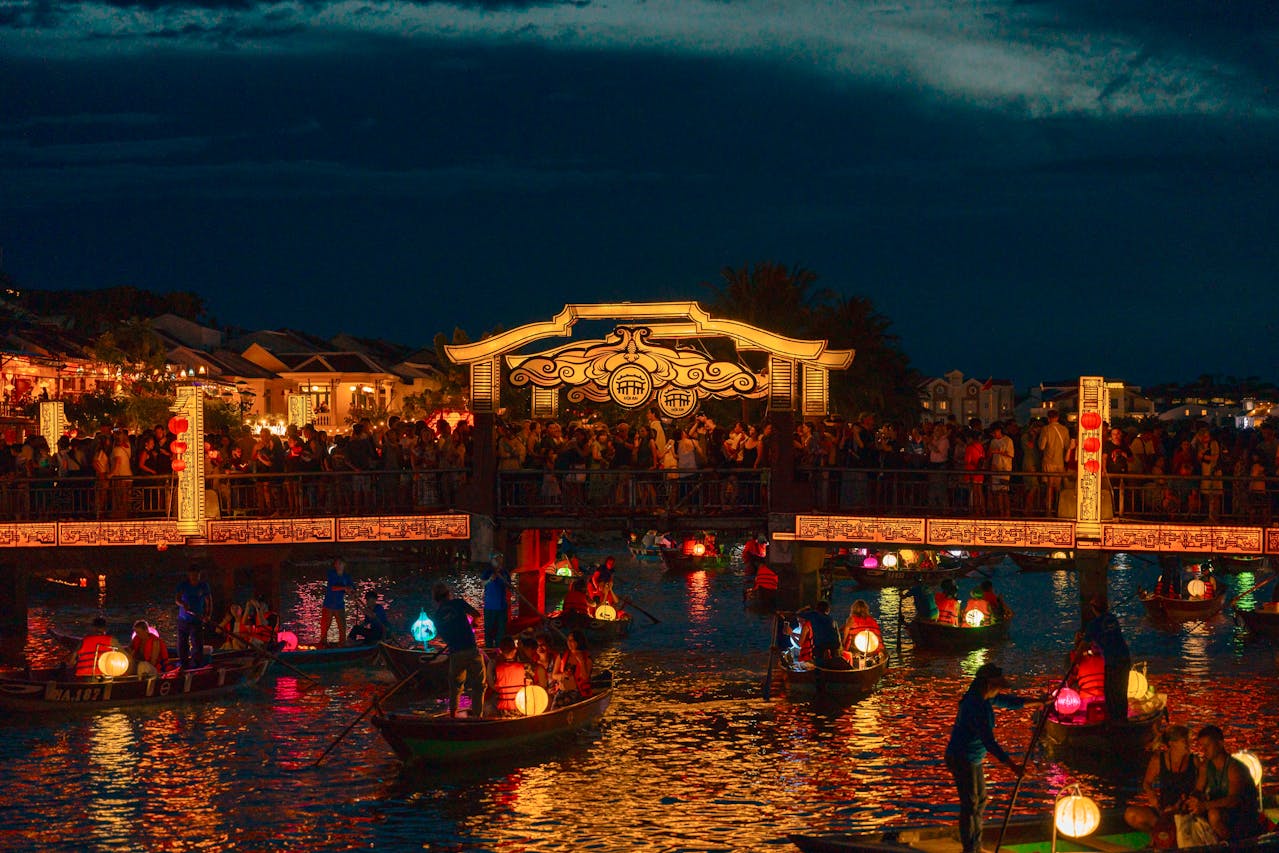 Begin your Hoi An Tours with a scenic adventure (Source: Internet)
Begin your Hoi An Tours with a scenic adventure (Source: Internet)Our sustainable tours offer immersive experiences at the Japanese Covered Bridge, tailored for eco-conscious travelers:
Hoi An Heritage Walking Tour ($55–$75/person): Japanese Covered Bridge, Phuc Kien Assembly Hall, Tan Ky House, Full Moon Lantern Festival. Includes Old Town ticket ($6), eco-transfers, and cao lầu tasting.
Hoi An Night Glow Tour ($55–$75/person): Bridge at sunset, lantern festival, Thu Bon River boat ride, night market. Includes eco-transfers and snacks.
Hoi An Heritage Cycling Tour ($60–$80/person): Bridge, Tra Que Village, An Bang Beach, cooking class. Includes bike rentals, eco-transfers, and lunch.
Hoi An & My Son Cultural Tour ($80–$120/person): Bridge, My Son Sanctuary, Thanh Ha Pottery Village. Includes Old Town ticket ($6), eco-transfers, and meals.
Central Vietnam Explorer ($350–$550/person, 3–4 days): Bridge, Hoi An, Da Nang, My Son, homestays ($15–$50/night). Includes all activities, meals, eco-transfers.
Prices include English-speaking guides, eco-transfers, entrance fees ($6), and meals/snacks. Group discounts (10% off for 10+ travelers) and seasonal promotions available. Book now via links around this page!
Japanese Covered Bridge, or Cau Pagoda, in Da Nang City’s Minh An Ward, is a 17th-century masterpiece blending Japanese, Vietnamese, and Chinese architecture, standing as Hoi An’s cultural heart. With a $6 Old Town ticket, 24/7 access, and recent 2024 restoration, it captivates with its historic charm and spiritual serenity. From sunset photos to Full Moon Lantern Festival visits, it’s a UNESCO highlight. Supported by sustainable practices like eco-tours and biodegradable packaging, the bridge thrives as a responsible tourism icon. Legend Travel Group’s Hoi An Tours guide you through this iconic bridge, ensuring a sustainable Hoi An Travel experience that supports Minh An’s community and preserves heritage. Don’t miss this Hoi An gem—browse our featured tours and book your adventure today!
Ready to explore the Japanese Covered Bridge in Hoi An? Reserve your tour with Legend Travel Group and immerse yourself in Vietnam’s cultural legacy sustainably!
Author Bio: Written by Tony Bùi at Legend Travel Group, with over 20 years of experience in the travel industry, guiding 100,000+ travellers across Southeast Asia. This guide draws from firsthand insights, guest feedback from Legend Travel Group surveys.
Favorite experiences booked by travelers